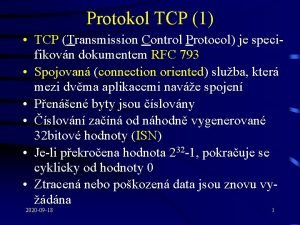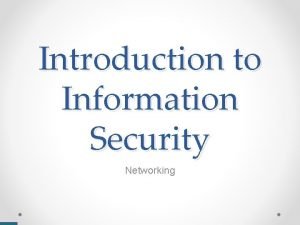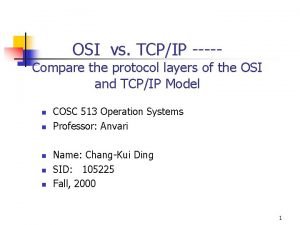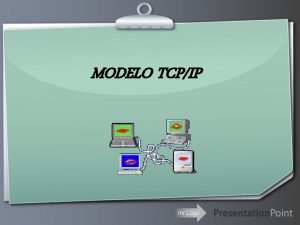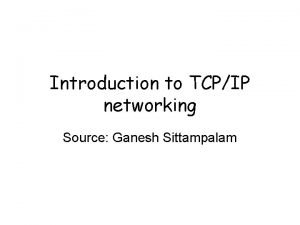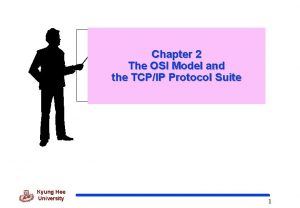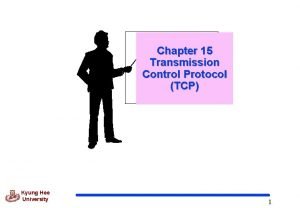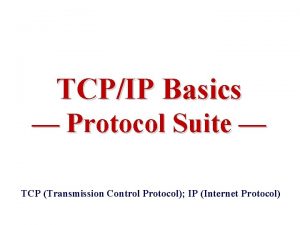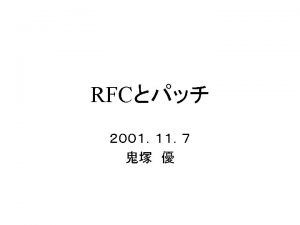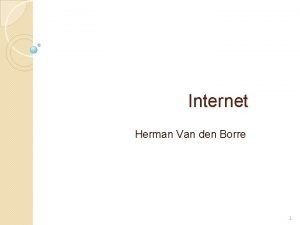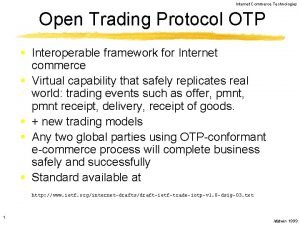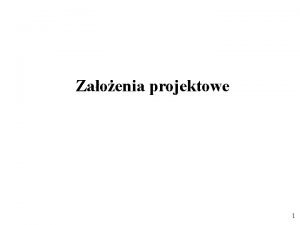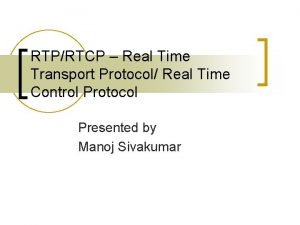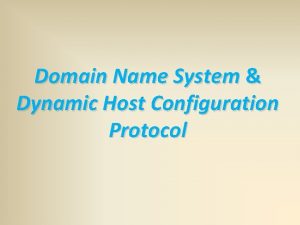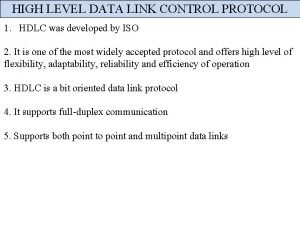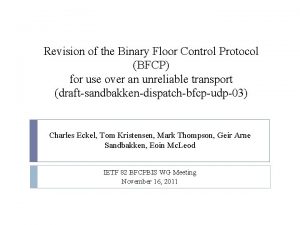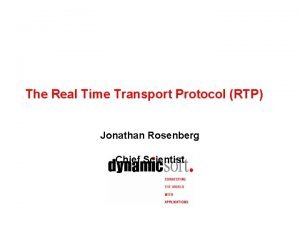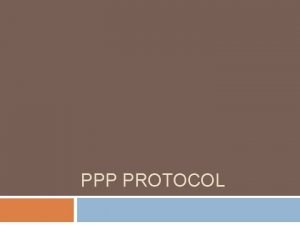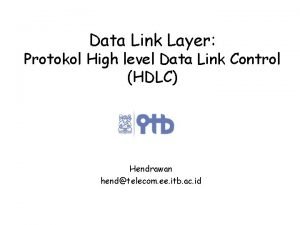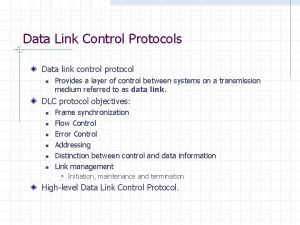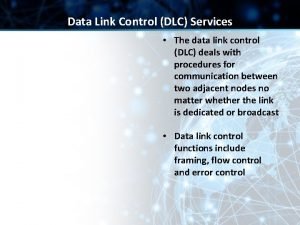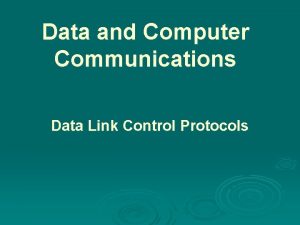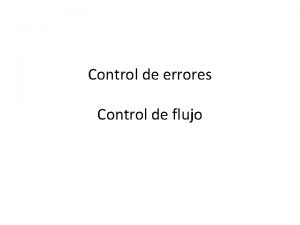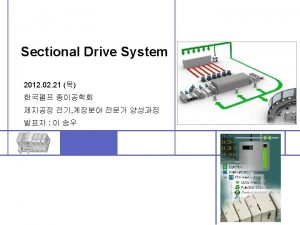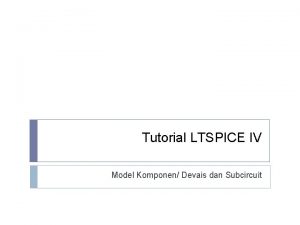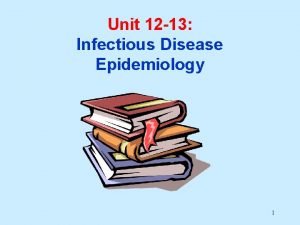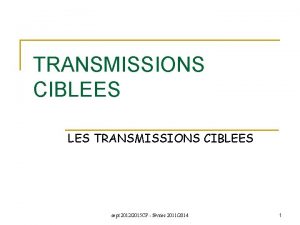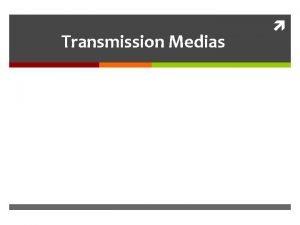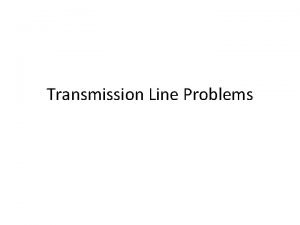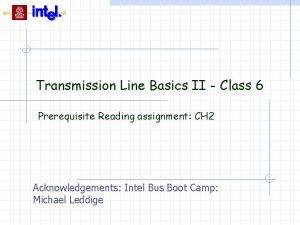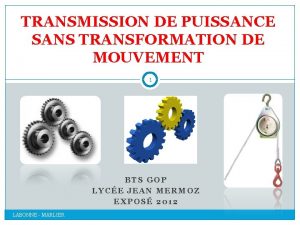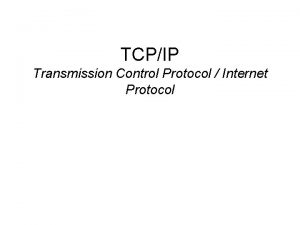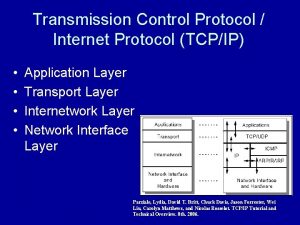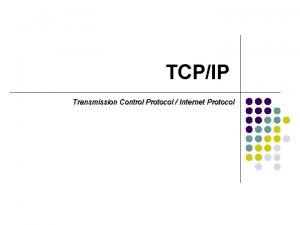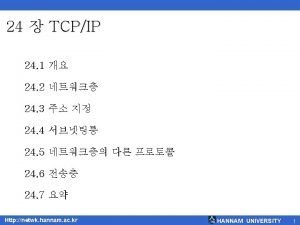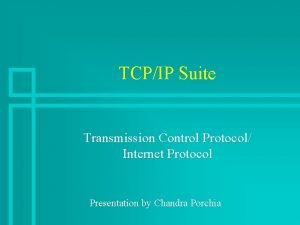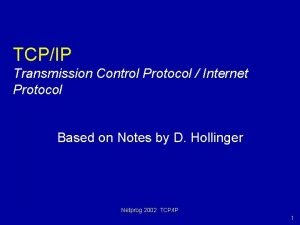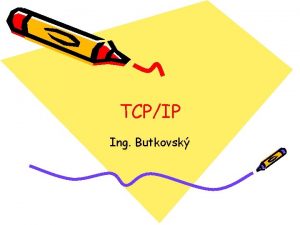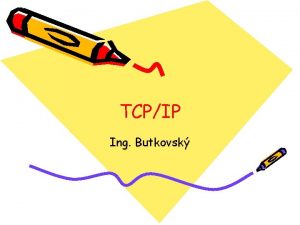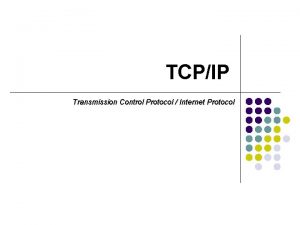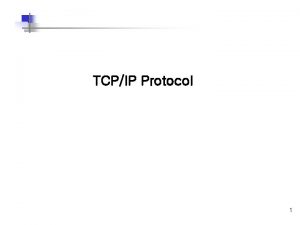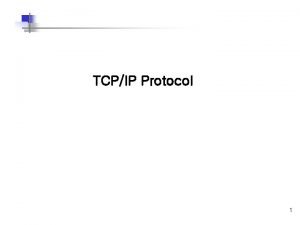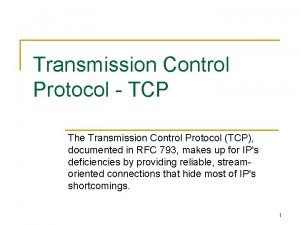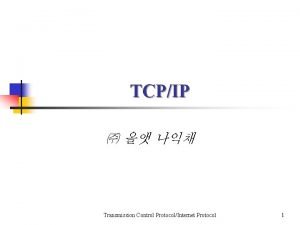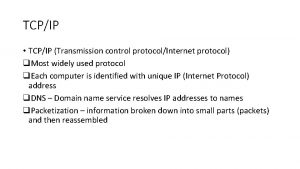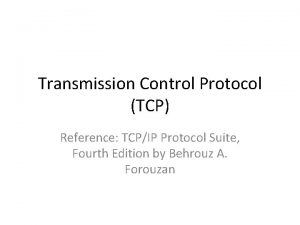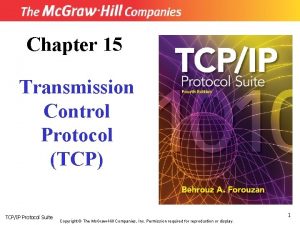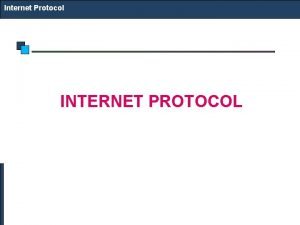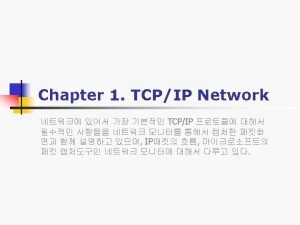TCPIP Transmission Control Protocol Internet Protocol 1 TCPIP























































- Slides: 55

TCP/IP Transmission Control Protocol / Internet Protocol 1

TCP/IP & OSI u In OSI reference model terminology -the TCP/IP protocol suite covers the network and transport layers. u TCP/IP can be used on many data-link layers (can support many network hardware implementations). 2

But First. . . 3

Ethernet - A Real Data-Link Layer u It will be useful to discuss a real data-link layer. u Ethernet (really IEEE 802. 3) is widely used. u Supported by a variety of physical layer implementations. 4

Ethernet u Multi-access (shared medium). u Every Ethernet interface has a unique 48 bit address (a. k. a. hardware address). u Example: C 0: B 3: 44: 17: 21: 17 u The broadcast address is all 1’s. u Addresses are assigned to vendors by a central authority. 5

CSMA/CD Carrier Sense Multiple Access with Collision Detection u Carrier Sense: can tell when another host is transmitting u Multiple Access: many hosts on 1 wire u Collision Detection: can tell when another host transmits at the same time. 6

An Ethernet Frame Preamble Destination Address Source Address Length DATA CRC 8 bytes 6 6 2 0 -1500 4 u The preamble is a sequence of alternating 1 s and 0 s used for synchronization. u CRC is Cyclic Redundency Check 7

Ethernet Addressing u Each interface looks at every frame and inspects the destination address. If the address does not match the hardware address of the interface or the broadcast address, the frame is discarded. u Some interfaces can also be programmed to recognize multicast addresses. 8

Back to TCP/IP 9

Internet Protocol The IP in TCP/IP u IP is the network layer u packet delivery service (host-to-host). u translation between different data-link protocols. 10

IP Datagrams u IP provides connectionless, unreliable delivery of IP datagrams. u Connectionless: each datagram is independent of all others. u Unreliable: there is no guarantee that datagrams are delivered correctly or at all. 11

IP Addresses are not the same as the underlying datalink (MAC) addresses. Rensselaer u IP Why ? 12

IP Addresses u IP is a network layer - it must be capable of providing communication between hosts on different kinds of networks (different datalink implementations). u The address must include information about what network the receiving host is on. This makes routing feasible. 13

IP Addresses u IP addresses are logical addresses (not physical) u 32 bits. u Includes a network ID and a host ID. u Every host must have a unique IP address. u IP addresses are assigned by a central authority (the NIC at SRI International). 14

fore! The four formats of IP Addresses Class A 0 Net. ID B 10 C 110 D 1110 Host. ID Net. ID 8 bits Host. ID Net. ID Multicast Address 8 bits 15

Class A l 128 possible network IDs l over 4 million host IDs per network ID Class B l 16 K possible network IDs l 64 K host IDs per network ID Class C l over 2 million possible network IDs l about 256 host IDs per network ID 16

Network and Host IDs u. A Network ID is assigned to an organization by a global authority. u Host IDs are assigned locally by a system administrator. u Both the Network ID and the Host ID are used for routing. 17

IP Addresses u IP Addresses are usually shown in dotted decimal notation: 1. 2. 3. 4 000000010 00000011 00000100 u cs. rpi. edu is 128. 213. 1. 1 10000000 11010101 00000001 CS has a class B network 18

Host and Network Addresses u. A single network interface is assigned a single IP address called the host address. u A host may have multiple interfaces, and therefore multiple host addresses. u Hosts that share a network all have the same IP network address (the network ID). 19

IP Broadcast and Network Addresses u An IP broadcast addresses has a host ID of all 1 s. u IP broadcasting is not necessarily a true broadcast, it relies on the underlying hardware technology. u An IP address that has a host ID of all 0 s is called a network address and refers to an entire network. 20

Subnet Addresses u An organization can subdivide it’s host address space into groups called subnets. u The subnet ID is generally used to group hosts based on the physical network topology. 10 Net. ID Subnet. ID Host. ID 21

Subnetting router Subnet 1 128. 213. 1. x Subnet 2 128. 213. 2. x Subnet 3 128. 213. 3. x 22

Subnetting u Subnets can simplify routing. u IP subnet broadcasts have a host. ID of all 1 s. u It is possible to have a single wire network with multiple subnets. 23

Mapping IP Addresses to Hardware Addresses u IP Addresses are not recognized by hardware. u If we know the IP address of a host, how do we find out the hardware address ? u The process of finding the hardware address of a host given the IP address is called Address Resolution 24

Reverse Address Resolution u The process of finding out the IP address of a host given a hardware address is called Reverse Address Resolution u Reverse address resolution is needed by diskless workstations when booting. 25

ARP u The Address Resolution Protocol is used by a sending host when it knows the IP address of the destination but needs the Ethernet address. u ARP is a broadcast protocol - every host on the network receives the request. u Each host checks the request against it’s IP address - the right one responds. 26

ARP u ARP does not need to be done every time an IP datagram is sent - hosts remember the hardware addresses of each other. u Part of the ARP protocol specifies that the receiving host should also remember the IP and hardware addresses of the sending host. 27

ARP HEY - Everyone please listen! Will 128. 213. 1. 5 please send me his/her Ethernet address not me Hi Red! I’m 128. 213. 1. 5, and my Ethernet address is 87: A 2: 15: 35: 02: C 3 28

RARP HEY - Everyone please listen! My Ethernet address is 22: BC: 66: 17: 01: 75. Does anyone know my IP address ? not me Hi Red ! Your IP address is 128. 213. 1. 17. 29

Services provided by IP u Connectionless Delivery (each datagram is treated individually). u Unreliable (delivery is not guaranteed). u Fragmentation / Reassembly (based on hardware MTU). u Routing. u Error detection. 30

IP Datagram 1 byte VERS HL Service Fragment Length Datagram ID FLAG Fragment Offset TTL Protocol Header Checksum Source Address Destination Address Options (if any) Data 31

IP Datagram Fragmentation u Each fragment (packet) has the same structure as the IP datagram. u IP specifies that datagram reassembly is done only at the destination (not on a hopby-hop basis). u If any of the fragments are lost - the entire datagram is discarded (and an ICMP message is sent to the sender). 32

IP Datagram Fragmentation u If packets arrive too fast - the receiver discards excessive packets and sends an ICMP message to the sender (SOURCE QUENCH). u If an error is found (header checksum problem) the packet is discarded an ICMP message is sent to the sender. 33

ICMP Internet Control Message Protocol u ICMP is a protocol used for exchanging control messages. u ICMP uses IP to deliver messages. u ICMP messages are usually generated and processed by the IP software, not the user process. 34

ICMP Message Types u Echo Request u Echo Response u Destination Unreachable u Redirect u Time Exceeded u Redirect (route change) u there are more. . . 35

IP/BYE-BYE u IP/BYE-BYE is a lecture protocol used to signal the class that we have just finished our discussion of IP - the network layer of TCP/IP. u The appropriate response to an IP/BYEBYE request is immediate applause, although simply opening your eyes is enough (known as a WAKEUP response). 36

Transport Layer & TCP/IP Q: We know that IP is the network layer - so TCP must be the transport layer, right ? A: No. TCP is only part of the TCP/IP transport layer - the other part is UDP (User Datagram Protocol). 37

Process TCP UDP ICMP, ARP & RARP IP Hardware Process Layer Transport Layer Network Layer Data-Link Layer 38

UDP u UDP is a transport protocol u communication between processes u UDP uses IP to deliver datagrams to the right host. u UDP uses ports to provide communication services to individual processes. 39

Ports u TCP/IP uses an abstract destination point called a protocol port. u Ports are identified by a positive integer. u Operating systems provide some mechanism that processes use to specify a port. 40

Host A Ports Host B Process Process 41

UDP u Datagram Delivery u Connectionless u Unreliable u Minimal UDP Datagram Format Source Port Destination Port Length Checksum Data 42

TCP Transmission Control Protocol u TCP is an alternative transport layer protocol supported by IP. u TCP provides: u Connection-oriented u Reliable u Full-duplex u Byte-Stream 43

Connection-Oriented u Connection oriented means that a virtual connection is established before any user data is transferred. u If the connection cannot be established - the user program is notified. u If the connection is ever interrupted - the user program(s) is notified. 44

Reliable u Reliable means that every transmission of data is acknowledged by the receiver. u If the sender does not receive acknowledgement within a specified amount of time, the sender retransmits the data. 45

Byte Stream u Stream means that the connection is treated as a stream of bytes. u The user application does not need to package data in individual datagrams (as with UDP). 46

Buffering u TCP is responsible for buffering data and determining when it is time to send a datagram. u It is possible for an application to tell TCP to send the data it has buffered without waiting for a buffer to fill up. 47

Full Duplex u TCP provides transfer in both directions. u To the application program these appear as 2 unrelated data streams, although TCP can piggyback control and data communication by providing control information (such as an ACK) along with user data. 48

TCP Ports u Interprocess communication via TCP is achieved with the use of ports (just like UDP). u UDP ports have no relation to TCP ports (different name spaces). 49

TCP Segments u The chunk of data that TCP asks IP to deliver is called a TCP segment. u Each segment contains: u data bytes from the byte stream u control information that identifies the data bytes 50

TCP Segment Format 1 byte Source Port Destination Port Sequence Number Request Number offset Reser. Control Window Checksum Urgent Pointer Options (if any) Data 51

Addressing in TCP/IP u Each TCP/IP address includes: u Internet Address u Protocol (UDP or TCP) u Port Number 52

TCP vs. UDP Q: Which protocol is better ? A: It depends on the application. TCP provides a connection-oriented, reliable byte stream service (lots of overhead). UDP offers minimal datagram delivery service (as little overhead as possible). 53

TCP/IP Summary u IP: network layer protocol u unreliable u UDP: u transport layer protocol unreliable datagram delivery between processes. u TCP: u datagram delivery between hosts. transport layer protocol reliable, byte-stream delivery between processes. 54

Hmmmmm. TCP or UDP ? u Internet commerce ? u Video server? u File transfer? u Email ? u Chat groups? u Robotic surgery controlled remotely over a network? 55
 4-way handshake
4-way handshake Tcp (transmission control protocol) to protokół
Tcp (transmission control protocol) to protokół Transmission control protocol
Transmission control protocol Osi
Osi Tcpip
Tcpip Modelo tcpip
Modelo tcpip Iso osi vs tcp ip
Iso osi vs tcp ip Arquitetura tcp-ip
Arquitetura tcp-ip Que significa
Que significa Ganesh sittampalam
Ganesh sittampalam Ois 7계층
Ois 7계층 Transmission control block
Transmission control block Internet or internet
Internet or internet Security architecture for the internet protocol
Security architecture for the internet protocol Internet transport protocol in computer networks
Internet transport protocol in computer networks Protocol
Protocol Internet official protocol standards
Internet official protocol standards Internet protocol cursus
Internet protocol cursus Internet open trading protocol
Internet open trading protocol Schemat logiczny sieci komputerowej
Schemat logiczny sieci komputerowej Iptv internet protocol television
Iptv internet protocol television Adaptive internet protocol
Adaptive internet protocol Skinny protocol
Skinny protocol Real time control protocol
Real time control protocol Domain host control protocol
Domain host control protocol 1hdlc
1hdlc Bfcp sip
Bfcp sip Real time control protocol
Real time control protocol The ppp link control protocol was terminated
The ppp link control protocol was terminated High level data link control protocol
High level data link control protocol Data link control protocols in computer networks
Data link control protocols in computer networks Dlc protocol
Dlc protocol Communication data link
Communication data link Translational research institute on pain in later life
Translational research institute on pain in later life Difference between process control and product control
Difference between process control and product control Control volume vs control surface
Control volume vs control surface Stock control e flow control
Stock control e flow control Control volume vs control surface
Control volume vs control surface Difference between positive and negative control
Difference between positive and negative control Positive and negative controls
Positive and negative controls Hdlc adalah
Hdlc adalah Control de errores
Control de errores Negative control vs positive control examples
Negative control vs positive control examples Control flow error
Control flow error Scalar control vs vector control
Scalar control vs vector control Salin teks di foto
Salin teks di foto Advantages and disadvantages of wireless power transmission
Advantages and disadvantages of wireless power transmission Wireless power transmission project report doc
Wireless power transmission project report doc Source
Source Factors that affect disease transmission
Factors that affect disease transmission Macrocible entrée
Macrocible entrée What are the two types of transmission media?
What are the two types of transmission media? Transmission line example problems
Transmission line example problems Transmission line basics
Transmission line basics Mouvement
Mouvement Transmission de puissance
Transmission de puissance
